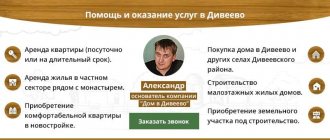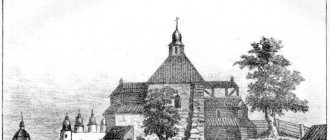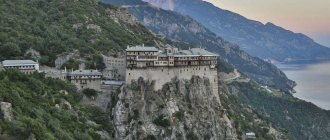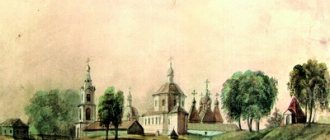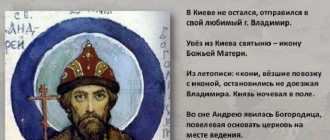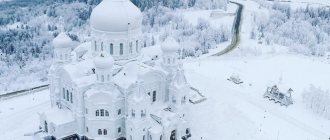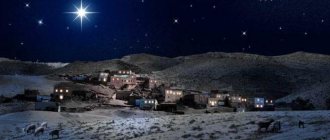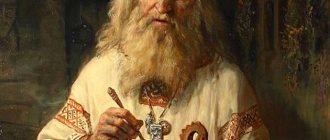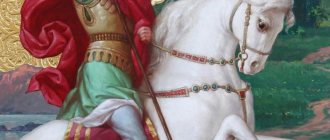Operating mode:
- November-May (from 10 a.m. to 4 p.m.).
- June-October (from 10 to 18 hours).
Entrance fee : free, visit to the museum at the monastery 5 €
How to get there:
The Kykkos Monastery is located high in the Troodos Mountains. Therefore, you can get there either by rented car or as part of an excursion.
- By your car. Where is the best place to rent a car in Cyprus? GPS coordinates: 34.9840368, 32.7418495. Below you will find a complete detailed description of the Kykkos Monastery; you can save this page on your smartphone to explore everything on your own, without a guide.
- View along with a tour.
For example - Big trip to Troodos - an 8-hour excursion, visiting the most famous monasteries and villages in Cyprus. View all excursions in Cyprus.
Attraction rating: 4.8 out of 5 based on 143 reviews.
Top traveler reviews for this place:
- A large active monastery. The monastery is decorated with many wonderful frescoes. Very beautiful! Inside the main temple there are many relics of Saints. Incredibly beautiful carved iconostasis. The Kik image of the Virgin Mary is located in the main church. If you have the opportunity, come on your own, not with a tour. Many tour guides are extremely incompetent and say stupid things (which we witnessed, since they speak very loudly and can hear everyone around them, not just their group of tourists). There are always a lot of tourists here, not pilgrims, so arrive early. And you should dress decently if you are going to a monastery. At the entrance there are dressing gowns for those who did not arrive in proper attire. Shops and church shops have a large selection, but the price tag is much higher compared to other monasteries.
- Interesting place, unexpected style. It bears little resemblance to an Orthodox monastery. More like a museum in an old palazzo.
- The drive from Protaras took about two hours. The serpentine road is very picturesque. The church itself is notable for the collection of a large number, in my opinion, about 20, of the relics of saints. For 5 euros you can visit a museum with a collection of icons and various religious attributes. The walls of the courtyard and monastery are decorated with frescoes. Everything is very beautiful.
- I recommend it to everyone, great place. As they used to write, this is the most important monastery in Cyprus. A large number of relics. Take everyone's crosses so you can touch the icons with them. Don’t take a bus tour; you’ll get tired and vomit all over the road after a 1.5 hour ride along hard serpentine roads. We went by car and that's it, but it's fun to look at the beauty. My passenger arrived crumpled like minced meat, she walked away from the road for half an hour.
- Probably the most important monastery in Cyprus. Definitely worth a visit. Take a tour and head to the mountains. Only by heading to the mountains can you see another Cyprus. Not the lifeless desert on the shore, but the forests and canyons of the mountains. The monastery itself is very rich. The beauty is incredible. The main shrine is the icon of Our Lady of Kik. Spare no effort or time to visit this unique place.
- This is one of the must visit places. Take your time. Take a car or a private tour. And again, only before or after the buses. In winter, this monastery seemed especially touching to me, as if above the earth. Essentially this is a 4 excursion in one. A monastery of one of the most valuable icons, a place to buy hand-painted icons for your home, a journey through a mountain forest, incredible views of the sea, a bell tower.
- Bring water and a bag with you)))), because... I get very sick on the mountain serpentines, but this place is truly the most beautiful of all that is on the island!!!!! a very rich museum, entrance 5 euros per person, beautiful mosaics on the walls, clean mountain air, silence, birdsong and peace!
- The best wine of Cyprus is located in this monastery.
Description of the Kykkos Monastery
The Kykkos monastery has always played a special role in the historical fate of Cyprus, sharing the fate of the people, which in difficult periods of its existence the brethren tried to inspire, guide on the right path and protect. This is why the Kykkos Monastery, the most famous Cypriot monastery, means so much to Cypriots.
The full name of the monastery is: the sacred royal and stauropegial monastery of the Kykkos Icon of the Mother of God. It is called royal because it was founded on personal monetary donations from the Byzantine emperor Alexei Komnenos (1081–1118); stauropegial - because a cross was placed on the foundation stone, and in the administrative language of the Church this means that the monastery has self-government, of course, within the framework of the Cypriot Orthodox Church. The origin of the name "Kykkos" is unknown. According to a common point of view, it goes back to the name of a wild shrub growing in the area, also called cocos. Tradition connects the name “Kykkos” with the singing of a certain bird, which in Byzantine times flew around the surrounding mountains and heralded the founding of the monastery with the following verses: “On the Kykkos, Kykkos mountain there will be a monastery, / The Golden Lady will enter it and will never leave.”
This is what actually happened, since in the monastery, which was built on the Kykkos mountains, the miraculous icon of the Mother of God of Kykkos has been kept since the end of the 19th century.
The monastery is located in the western part of the Troodos mountain range at a distance of only 18 km from the highest mountain peak of Cyprus - Olympus. It was built at an altitude of approximately 1200 m above sea level, among lush vegetation - bushes and trees. As we can see, the location of the monastery is very convenient for here, without being distracted by anything, to indulge in the feat of prayer.
The monastery has existed for 900 years, and its brethren devoted themselves not only to monastic work. The works of the inhabitants of the monastery were also aimed at strengthening the national identity of the Cypriots; led a monastery and a lot of charitable work. Thanks to all this, the Kykkos monastery rightfully began to be considered one of the most important spiritual centers of the island. She has always stood guard over the historical memory and Orthodox consciousness of the Cypriots, who had to endure many difficult trials, including many years of enslavement by foreign invaders, which carried the threat of the complete disappearance of the Cypriots as a people.
Founding of the monastery
As legend tells, one day - it was around 1100 - the Byzantine governor of Cyprus, Archon Manuel Voutomitis, went hunting, but got lost. He wandered for a long time in the then impenetrable forests of Troodos, inhabited by rare animals and birds. Finally, he met a hermit named Isaiah, but the proud archon treated him rudely, and the ascetic, who avoided everything worldly, did not talk to the nobleman. With difficulty, Voutomitis found the road to Nicosia. Soon the archon fell seriously ill. Deciding that the illness was sent to him as punishment for being rude to the ascetic of God, the archon sent servants to find Isaiah. The elder was brought to the ruler, and Vutomitis humbly asked to forgive him. Without saying anything in response, the monk began to pray for the healing of the suffering person. Feeling that the illness had subsided through the prayers of the elder, Vutomitis promised Isaiah to give everything that he asked of him. However, the saint did not want money or titles, but, following the Divine command, asked Voutomitis to bring him from Constantinople an icon of the Mother of God - one of the three that the Evangelist Luke painted. The ruler hesitated, because he was not sure that he could convince the emperor of Byzantium, Alexei Komnenos, to give up the holy image kept in the palace. Nevertheless, Vutomitis went to Constantinople, taking with him the elder Isaiah.
They found the emperor in great sorrow, because his only daughter was seriously ill with the same disease that had previously struck Voutomitis. When the archon and monk who appeared before Alexei Komnenos learned about this, the elder began to fervently pray to the Lord. His prayer was heard, and the imperial daughter was completely healed. The guests told the emperor that, according to God's will, they should transfer the holy icon to the Troodos mountains. It was difficult for Alexei Komnenos to part with the precious shrine. Only when he himself was struck by the same disease did he understand: God wanted him to give up the icon. The emperor also gave the funds necessary to build a monastery for the image. Isaiah with great joy brought the icon to Cyprus. Here the people met the icon of the Mother of God with special excitement and reverence, and then solemnly escorted it to the Troodos mountains. The trees along the procession's path bowed low, and shells miraculously emerged from the sea and followed the procession. Even today, in the forest areas of Tilliria, you can find bent pine trees and see sea shells - these witnesses to the amazing participation of nature in the meeting that Cyprus prepared for the icon of the Mother of God. At the same time, Voutomitis also returned to the island, who presented Isaiah with the imperial charter-chrisovul, which declared the monastery stauropegial and designated the villages of Peristerona, Milos and Milikouri for its maintenance.
The earliest mention of the Kykkos monastery is found in a manuscript from 1136: it talks about the purchase of a certain book by the then abbot of the monastery, Daniel. Other information about both the first years of the monastery’s existence and the entire Byzantine period of its history goes back to texts of later times. Despite their indirect nature, these evidence convinces us that the monastery had a significant influence on the then spiritual life of the island. Convincing evidence of this can be found in icons painted in the style of the Kykkos image of the Mother of God, which have survived to this day in Sinai and southern Italy.
Latin dominance (1191–1571)
Under the Latins, the Cypriot people did not abandon their ardent love for the Kykkos image of the Mother of God. It is even mentioned in Venetian documents with the name “Holy Mary of the Rain” - a fact that indicates the wide popularity of the icon among the heterodox conquerors. The glory and influence of the Kykkos monastery were so great that after the fire of 1365, the Catholic King Peter (1359–1369) himself expressed his readiness to restore the monastery, thereby wanting to express his favor to his subjects. But his wife Eleanor begged him to allow her to allocate funds for the restoration of the monastery.
During the period of Latin rule, thanks to the manuscripts created in the monastery, Orthodox traditions and the Greek language were preserved and continued, and the historical memory of the Cypriot people remained alive. The monastery had a workshop for copying and decorating manuscripts, which continued Byzantine traditions. The Patriarchal Library of Jerusalem contains a handwritten Psalter that came out of the scriptorium of the Kykkos Monastery, convincingly demonstrating the highest skill of the Cypriot monks. Although, due to historical and a number of other reasons, many texts from that era have been lost, their spiritual influence is felt through the copies of the Kykkos Icon of the Mother of God, which were made in the 13th–15th centuries and preserved both in Cyprus and in other places. This is the icon of the Church of the Mother of God of Kivotou (XIII century), which is in the community of St. Theodore in Agra, the icon of the Church of St. Marina (XV century) of the village of Kalopanagiotis, now kept in the Museum of Byzantine Antiquities at the Foundation of Archbishop Macarius III, and the icon of the Church of the Mother of God of Dexia (XV century) in Thessaloniki.
Turkish domination (1571–1878)
The dark period of Turkish rule became a serious test for Cypriot Hellenism. The heterodox conqueror brought with him a culture and a different religion that was completely alien to the Cypriots, which he tried with all his might to impose on them. To achieve these goals, a large military contingent was stationed in Cyprus, and Muslim communities were created. Based on the ideology of Islam, the Ottoman Empire believed that it had the right to brutally exploit the conquered peoples, who, as a result, were in a state of spiritual impoverishment and constant danger of physical destruction.
In the new conditions, the only organized force and hope of the people remained the Church, which protected, strengthened and guided them. The Kykkos monastery made a huge contribution to this struggle. During the period of Turkish rule, when religious faith also meant national identity, the monastery maintained a religious consciousness, which was a breakwater against Islamization, which ultimately led to complete Turkification. Thousands of refugees, ignoring the difficulties of the path and many other dangers, went to the monastery for days and weeks to pray, ask for help from the holy icon and at the same time gain courage and patience to withstand the troubles of slavery.
Monastic farmsteads scattered throughout Cyprus were also a refuge for Christians, the main of which were: Arkhangelskoe in Lakatamia, St. Procopius in Ergomi, Xiropotamskoe in Pandagia and Sinti in Paphos.
But this was not the only way the Kykkos monastery resisted Turkification. Within its walls the arts, icon painting, wood carving developed, and the traditions of Greek education were preserved and enhanced. Evidence of this is codices, musical manuscripts, shrines and numerous documents stored in the Kykkos monastery itself and in other places in Cyprus, as well as in private collections, museums, libraries and archives of other countries. It is difficult to overestimate the importance of the Greek school that operated in the monastery since the 18th century, albeit somewhat imperfect from today’s point of view. The teacher of the nation, Ephraim the Athenian, taught there, and the students were not only novices of the monastery. After graduating from school, young people returned to their homeland and there - either in the priesthood or as teachers - they spread the knowledge they had acquired. The school of the Kykkos monastery later developed into a three-year Greek gymnasium. Many of her students continued their studies at theological faculties in Athens, Halki, the School of the Holy Cross in Brooklyn, and Jerusalem. Their subsequent spiritual activity is another contribution of the monastery.
From independence (1960) to this day
The long liberation struggle of the Cypriot people ended with the founding of the independent state of the Republic of Cyprus (1960), which had to face many more difficulties. The Turkish invasion of 1974 led to tragic consequences: the occupation of 40% of the island, the forced expulsion of a third of the population and 1,619 missing.
During the years of independence, the Church continued to play a leading role in the political and social events of the country. The traditions of the Kykkos monastery were not interrupted either. The monastery was at the forefront of the struggle for national justice, democracy and spiritual prosperity. He developed a multifaceted activity and was again close to the people, helping them in many needs. From the very beginning, the monastery allocated a significant amount of its income for the founding of schools, such as the once famous Kykkos Men's Gymnasium (1961) and Kykkos Women's Gymnasium (1964), now the 1st and 2nd Kykkos Lyceums, respectively. For the totality of its spiritual contribution, the monastery of the Kykkos Icon of the Mother of God received a special award from the Athens Academy of Sciences in 1974.
The monastery also provided significant assistance to those residents who were persecuted by Turkish troops and who in 1974 sought refuge in the Kykkos Mountains. The monastery opened its doors and accepted thousands of refugees, giving them shelter, comfort and strength. At the same time, the monastery transferred large sums to the corresponding state funds, from where the funds were sent to help refugees. The monastic territories housed exiled educational institutions and spiritual centers, such as the Agricultural Gymnasium of Morphos, which for many years was located within the walls of a theological seminary. The monastery directed financial assistance for defense purposes, to improve the living conditions of soldiers, and to build barracks for the national guard.
Today, twenty monks and two novices work in the monastery. Since 1984, the rector of the monastery has been Bishop (now Metropolitan of Kykkos and Tillyria) Nicephorus, who is at the head of the brethren’s efforts to preserve the traditions of faithful service to the values and ideals of Hellenism and the Orthodox heritage of the island.
Nowadays, the monastery continues its multilateral activities, including in the social sphere, contributing to the establishment of the spiritual values of the people and at the same time the revival of its historical and cultural memory. The monastery donated large areas for the construction of schools, donated land to municipalities for the establishment of cultural centers, and used its own funds to equip entire laboratories for those who needed them, such as special schools for difficult-to-adapt children. He financed the construction of additional school facilities, such as the assembly hall of the Kykkos Lyceum in Paphos; created computer centers in various educational institutions, such as the Pedagogical Institute, the 1st Kykkos Lyceum and many others.
Monastery ensemble
The ensemble of the monastery consists of many heterogeneous architectural elements, since it was formed depending on the needs, conditions and financial capabilities of each era. The basis of the ensemble is the temple and various buildings around it, such as: the abbot's building, the meeting hall, monastic cells, a library, a museum, halls for receiving guests, an economic department and others. In the center is a tiled courtyard with a spring.
Today, the monastery premises have been mostly restored and decorated with images of various church subjects. For the most part, this is a mosaic that decorates the entrance, the walls of the courtyard and corridors, harmoniously fitting into the architectural features of the place.
The patronal feast day of the monastery of the Kykkos Icon of the Mother of God is September 8 - the Nativity of the Virgin Mary, although all the Mother of God holidays are solemnly celebrated in the monastery. On the holiday of the ancient monastery, thousands of pilgrims flock here. Most of them live in new guest buildings, which have recently been built along with other buildings next to the monastery complex in order to make accommodation more convenient for pilgrims and other visitors who come to the monastery in large numbers throughout the year.
In the surrounding area there are also monastic buildings, such as the Church of St. Basil the Great, the Church of St. Andrew the Apostle and an ambelikia with rose bushes from which fragrant rose water is produced.
The monastery, apparently, was not built according to a single plan. It was built in several stages in accordance with the requirements of the natural landscape.
Today it looks like this: two stone-paved courtyards, located at different levels, with two entrances, surround the cell buildings. On the lower level, the courtyard is limited from the north by the main monastery church (katholikon), from the south by the middle building, from the east by a two-story building where the eastern entrance to the monastery is located, the so-called “Kato Kamara,” and from the west by a reservoir turned into a museum.
On the upper level, where the central entrance to the monastery is located, the courtyard is limited on the north by the middle building, and on the south, east and west by other corresponding buildings. The vaults form porticoes in front of the facades of the buildings around the courtyard.
On the first floor of the southern building there are cells, on the second - the monastery library. In the western building there are cells, a large meeting hall and a small chapel in the name of St. Charlampius. The middle four-story building consists of cells and storage rooms. In its eastern part there is a refectory, a kitchen and other premises. In the eastern building, next to the catholicon, there is a cell on the first floor, and on the second floor there are the abbot’s chambers. Both are richly decorated with wooden carvings. The monastery was built from local uncut stone. The monastery buildings were covered with kamars made of stones with a new gable roof made of concrete tiles.
Temple
The temple was built specifically to store the holy image. Initially it was wooden, like all monastery buildings. Wooden structures were easy prey for fires, which in 1365 and around 1541 caused serious damage to the monastery. At the same time, the magnificent frescoes that decorated it also perished. After the fire of 1541, the monastery was rebuilt, but this time the wood was replaced with stone. However, fires also occurred later, in 1751 and 1813. They caused the death of people, destroyed buildings inside the monastery, monastic cells and hotels, works of spiritual content and works of art dating back several centuries, and turned important manuscripts and historical documents into ashes.
The temple was originally one-nave, but later became three-nave. In its current architectural form, it is a domed basilica. The central altar is dedicated to the Mother of God, the right chapel is dedicated to all the saints, and the left chapel is dedicated to the archangels Michael and Gabriel.
The iconostasis, according to the existing inscription, was built in 1755, that is, immediately after the fire of 1751. Both he and the temple icons were miraculously saved from the last fire of 1813. The famous Kykkos Icon of the Mother of God is located in the center of the iconostasis, it is third in order to the left of the royal doors.
Most of the icons are painted in the Byzantine technique, although there are some that clearly show elements of Western influence. These include those icons that were painted at the end of the 18th century by the Cretan artist John Kornaros (1745–1812). The decor of the church is complemented by lamps, large candlesticks, chandeliers of amazing Russian work of the 18th–19th centuries and various liturgical vessels and offerings. A continuation of the temple is the bell tower, built only in 1882, since during the long period of Turkish rule the occupiers did not allow the ringing of bells. There are six bells on the bell tower, the largest of which, weighing 1280 kilograms, was cast in Russia.
Kykkos Icon of the Mother of God
The center of the Kykkos monastery is the icon of the Mother of God of Kykkos, which, according to tradition passed down from generation to generation, was painted by the holy Apostle Luke from the Mother of God herself. This holy icon is also known as the Virgin Mary ("Source of Mercy"). It depicts the Mother of God holding Christ on her right hand. This image is known throughout the Orthodox world. Many icons were painted from it in Greece, Russia, Georgia, Bulgaria, Egypt, Ethiopia, which indicates the great veneration that the icon enjoys among Orthodox peoples. In 1576, the icon was covered with a silver gilded chasuble, and a new chasuble was installed in 1795. The face of the Mother of God is closed and never opens, probably because this was the desire of Emperor Alexei Komnenos, or perhaps because this way the icon inspires more respect.
They say that in 1669 the Patriarch of Alexandria Gerasim dared to lift the veil and see the face of the Virgin Mary, but was punished for this blasphemy. With tears in his eyes, he was forced to ask God for forgiveness. The Russian monk Vasily (Barsky), who visited the monastery in 1735, writes that the monks open the face of the icon only during periods of rainlessness, and then only after first transporting it to the top of the neighboring mountain, known as the Throne, where they sing a prayer service, and the face They do not see the Virgin Mary, since it is facing the sky.
The people greatly honor the holy icon. The Mother of God of Kykkos is glorified in countless songs. There is a very large number of historical testimonies about the honors that were given to this icon during religious processions throughout the island. Believers from other countries revered her just as reverently. In the old days, when going on a pilgrimage to the Holy Land, they also stopped by Cyprus to visit this most famous monastery of the island. Naturally, today, when modern means of communication make travel easier and shorter, a huge number of pilgrims come to the icon. Believers from many parts of the world come to the monastery, resorting to the miraculous power of the Mother of God, asking for healing and to gain strength to endure life's trials.
In the temple we see offerings that testify to the miracles of the Mother of God. For example, a piece of the tongue of a swordfish was given as a gift - in memory of the salvation of the sailors of one ship from certain death, which in 1718 was pierced by this huge fish. One black man wanted to desecrate an icon, and for this his hand withered away, the image of which is located next to the icon as a reminder of this event. The miracles of the Mother of God are also sung in poems composed by various poets; These poems were published more than once in publications for the people. By the power of the holy icon, rain fell during periods of severe drought, barren wives gave birth, and the sick were healed. In the past, the islanders constantly asked the Kykkos monks to bring the icon to their villages for the sake of consecration, because they believed that its mere presence was enough to stop pestilence, epidemic, plague or any other natural disaster. But the icon especially helped during droughts. Historical sources contain references to frequent religious processions and prayers of the people asking for intercession, for the heavens to open.
During Turkish rule, Cypriots often resorted to the help of the holy icon. To transfer the icon and generally take it outside the monastery, a special permit was required, for the issuance of which Christians turned to the authorities with a corresponding petition. Often, Ottoman officials refused, and Christians, in order to obtain firman - permission, had to go all the way to the Sultan himself. Thus, a firman from 1643 reports that once the residents managed, by turning to the Sultan, to get rid of the arbitrariness of officials.
"Throne of the Virgin"
At the top of one of the mountains north of the monastery there is the “Throne of the Virgin Mary”. In the old days, there really was a wooden throne here, on which they placed an icon when they sent prayers to the Mother of God, asking for rain. In 1935, the place of the wooden throne was taken by a concrete edicule, which has recently been replaced by another, larger and more majestic. Nearby is the burial place of the first President of the Republic of Cyprus, Archbishop Macarius III (1913–1977), who was one of the brethren of the monastery.
Monastery Museum
The Museum of the Kykkos Monastery, which meets all modern scientific requirements and international standards, was opened in May 1998. It houses a rich collection of church utensils, old maps, engravings, antiquities and many other cultural heritage items of the island. Most of the church utensils, such as vestments, icons, books and manuscripts, were stored in the monastery before the opening of the museum, but the museum also contains exhibits that in past times were stolen, taken from Cyprus abroad, and now bought at auctions and returned to their homeland. The monastery has a workshop for the restoration of manuscripts, icons and monastery shrines, whose masters make a lot of effort to preserve the rich collection of the monastery.
The exhibition hall of the museum, according to the abbot of the Kykkos monastery, should not only meet high scientific criteria, but also be beautifully designed to reflect the glory and nobility of the Byzantine Empire. It must correspond to the word “royal” contained in the name of the monastery, and directly connect the monastery with the royal chambers of Constantinople, from where it traces its history and where it received the main shrine, since the Byzantine emperor Alexei Komnenos is considered the patron of the monastery. Following these instructions, the floors of the museum's exhibition halls were lined with multi-colored granite and marble, and the ceilings were inlaid with walnut wood, decorated with wood carvings and gilding.
The decor of the hall is complemented by a mosaic made from pieces of marble, depicting symbolic scenes, and stone bas-reliefs. The whole atmosphere of a richly decorated exhibition hall, illuminated in a special way, the sound of Byzantine chants, unique exhibits, most of which are made of precious materials: gold, silver, enamel, ivory, silk, porphyry, pearls and other precious stones, help the visitor to be transported mentally in ancient times and recreate in your imagination the glory and greatness of Hellenism and Orthodoxy.
The museum is located in the northwest of the old monastery ensemble. You enter it through a vaulted entrance, which is located on the north side of the upper large internal courtyard of the monastery. Having opened the heavy door, the visitor finds himself on the stairs leading to the museum lobby, where in the back, in a specially equipped place, is a museum shop. There you can buy a variety of souvenirs (books, slides, postcards, copies of exhibits, etc.).
Monastery courtyards
Most of the farmsteads operated in Cyprus, although some, also significant ones, were located in Constantinople, Smyrna and Georgia. Unfortunately, since 1974, the farmsteads of Ksiropotam, Avlona and Baradzhis, which found themselves in the occupied territory, fell into disrepair. According to available information, their condition is such that they could soon turn into ruins. The farmsteads are an integral component of the overall mosaic of the architectural ensemble of the Kykkos Monastery, but existing studies on this topic are few, moreover, most of them are already outdated, while others touch on specific issues of archaeology, architecture or art history.
Where is and how to get to the Kykkos Monastery
Travel to Cyprus starts from LCA - Larnaca Airport. The monastery is located in the Troodos Mountains. You can get to it by bus, rented car, or taxi. You can depart from the cities of Polis, Paphos and Limassol. You can also buy a transfer ticket for independent walks. An alternative and more economical option is to rent a car.
The route passes through the mountains, the road is serpentine. But it is safe and does not pose a threat if traffic rules are followed.
There are pockets along the way to stop and look at the beautiful nature around.
Why it's worth a visit
Being one of the most famous attractions in the world on the island of Cyprus, the Kykkos Monastery will be of interest to both tourists and pilgrims. The first ones will undoubtedly be attracted by the monastery with its antiquity, beauty and dramatic history. The monastery is located high in the mountains, the road to it is replete with breathtaking views, the air in the mountains is clean and healing, and the monastery is surrounded by centuries-old forests. For pilgrims heading to Kykkos from all over the world, the Orthodox shrines kept in the monastery are, of course, of interest.
© Anna Pushkareva
The miraculous icon of the Mother of God of Eleus
According to legend, the icon was painted by the Evangelist Luke from the Virgin Mary and at her request. That is why there is such reverent respect for her. Not only Orthodox Christians, but also non-Orthodox Christians turn to the Mother of God with their troubles. Through her intercession, rain is sent in times of drought, the weak and sick are healed, and the childless give birth to children. No wonder she is called Our Lady of Eleusa, which means “Merciful.” The inexhaustible mercy of the intercessor of all those who suffer, the comforter of the saddened.
Visitors to the monastery are interested in why the icon of the Mother of God cannot be seen. There is a belief that the power of the icon is such that whoever sees it can go blind. Therefore, for some time it has been covered with a silver frame decorated with gold, repeating the image. It was last changed in 1795. A veil decorated with jewels is thrown over it.
There are two main features of the icon that are characteristic of the Kykkos image. It depicts the Virgin Mary with a baby on her right hand, who is depicted in an unusual position. Looking at him, you might think that Jesus is trying to escape from the hands of his mother, and she is holding him back, trying to protect him from future trials. Another feature of the icon is the two veils on the head of the Virgin Mary. One is red, the other is black.
What to see along the way
The journey from Polis itself can become a colorful memory, because during the 60 km one-way trip you can see several more picturesque places in Cyprus.
If the departure point is Polis or Protaras, the following attractions are available:
- The village of Lysos. It has a beautiful church and fountain that represent the culture and spirit of Cyprus.
- Cedar Forest and Chapel of the Holy Cross. Stopping and taking a walk through the cedar forest is a good solution for those who want to breathe fresh air and admire the beauty of the trees.
- Folklore museum. Located in Nicosia, it will delight poetry lovers. It contains classic poems and books in authentic centuries-old bindings. At set hours, poetry readings are held in the authors’ language.
If the departure point is Limassol or Paphos, you will see the following:
- Village of Platres. It has good cafes that serve delicious lunches. In addition, you can see a waterfall coming down from the mountains.
- Kakopetria is a charming village on the way to the monastery. It is located on a cliff. The streets are paved with stone. The cozy atmosphere and friendly residents will delight and surprise all travelers. After visiting, you will be left with a pleasant aftertaste; the views make you think about life.
Village of Kakopetria.
Another favorite place for tourists is Archangelos Michael Church - a church in Crete.
But to visit it, you should plan more time on your trip, since the path to it will also allow you to get acquainted with many attractions.
Archbishop's burial place
In preparation for death, Archbishop Makarios himself chose the place for his resting place. Here, on the top of Troni, his words are remembered: “From here I will see all of Cyprus...”. The first President of Cyprus, His Beatitude Archbishop Makarios III, is buried near the chapel.
You need to go from the main entrance to the monastery, turn right and follow to the top of the mountain. The final resting place of Archbishop Makarios is majestic: a wide square, a monumental sculpture of the President.
The statue is 10 meters high and weighs 13 tons and is made of bronze. It was made by a Cypriot sculptor originally from the city of Morphou, living in London; for 21 years this statue adorned the square of the archbishop's residence in Nicosia.
But then it was moved here, despite the objections of some citizens. Archbishop of Cyprus Chrysostomos explained his decision by saying that the statue was more in harmony with the site, as well as his desire to pay respect to the First President of the Republic of Cyprus.
A wide road leads to the tomb of Makarios, decorated on both sides with high stone-lined volcanic rocks, walls decorated with mosaics, on which, as in the monastery, saints are depicted. Among these mosaics are images of St. Sergius of Radonezh and Seraphim of Sarov.
It is interesting that the inscriptions on these images, unlike all the others, are made in Russian. After 250 meters from the square, go to a narrow road going up on the left and after 100 meters there is a burial place.
The grave is covered by a marble slab with an inscription, this inscription is an excerpt from a speech by Makarios addressed to the Cypriot people. Soldiers stand guard of honor at the grave. Born into a poor peasant family, he rose to the heights of power, while remaining a very solid nature, unyielding and unshakable.
Prodromos (Prodromos − Πρόδρομος)
34.949900 32.832470 – fork in Prodromos
Stopping time: non-stop
Description: having descended along the same road from Olympus, we again reach the highway leading to Kykkos. We move about 6 km and find ourselves in the area of the town of Prodromos. Actually, I marked it on the map so that you don’t think too much about where to go next. Here you will find a ring with a fork in five directions. When you go “there”, you need to turn onto the nearest road on the right, leading down. This is clearly visible in the first photo. There is a descent from the mountain and then it continues in the opposite direction (in the photo the descent is on the left). But at the same time, you don’t need to try to turn there right away - make almost a circle around the ring, as the rules require. At the same time you will find out the temperature in the mountains. The second picture clearly shows that there is only plus 6, although in Limassol at that moment there were twenty-odd. Let’s make an adjustment for the time of shooting - it’s almost winter, November 28th.
Let's move on.
Transfer from the airport in Cyprus
Cyprus is a top summer destination and taxi drivers at the airport often raise prices for their services. In addition, most of them do not have child car seats. It is not installed because it takes up the seat of an adult passenger. Because of this, tourists with children have to run around the airport looking for a free car with a child car seat.
Both problems can be solved very simply. Transfers, both individual and group, can be ordered online. There you can also choose the option with a child seat. You won’t have to overpay taxi drivers and there will be no problems with the safety of children.
Everything happens very simply. After placing your order, you will be met by a driver holding a sign with your name written on it. Immediately after leaving the arrivals hall, you get into the car and drive to your hotel.
Find transfer options in Cyprus >>
Interesting facts and legends
There are many stories and events that are attributed to the action of the icon of the Mother of God:
- The monastery contains part of the tongue of a huge swordfish, which in 1720 tried to sink a ship with pilgrims. The power of the intercessor of the Mother of God helped people escape and reach the shore.
- Near the holy image in the temple there is a cast of the withered hand of a wicked man who tried to desecrate the icon.
- Every year the veil is removed from the face, the icon turns its face to the sky and rises to the chapel on the mountain; everyone firmly believes that this ritual brings the long-awaited rain.
- The healing power of the image of the Mother of God helps to get rid of various diseases, and women to conceive a child.
- During epidemics and natural disasters, the removal of icons to surrounding settlements prevented inevitable misfortunes.
In ancient Russian chronicles there is a description of the fact of desecration of the icon. The Arab shot an arrow at the icon, real blood flowed from the wound, the attacker ran home in fear, but death overtook him on the threshold.
Reviews from tourists
Reviews can be divided into two groups:
- The vast majority are positive. Those who visited the monastery share their impressions, feelings from touching the ancient shrines of Orthodoxy, the beauty and well-groomed nature of the monastery, and the splendor of the local nature.
- Negative reviews relate to everyday issues, the difficult serpentine climb, which makes you feel sick, as well as the short duration of the excursions.
The purest mountain air, the most beautiful places, the monastery complex, the miraculous icon affect a person in an inexplicable way, leaving no one indifferent.
More about the monastery complex
Kykkos is located among pine trees, on the Troodos slopes. The modern monastery complex is very different from the original buildings. Initially, all buildings were wooden. After the first fire, of which there were 4, wood and stones were used in construction.
It is significant that during the fourth fire, the icon of the Most Holy Mother of God, which has miraculous powers, was not damaged. The Monastery of the Holy Virgin Kykkos is visited by pilgrims and vacationers asking the shrine for healing and help.
The modern monastery complex includes buildings located on two levels:
- To the north is the main temple, and to the south are the cell buildings on the lower level.
- Upstairs there is a library and a refectory.
- There is a well in the stone-lined yard.
- A museum was built on the north side at a height.
First President of the Republic of Cyprus, Archbishop Makarius III
The name of the First President of the Republic of Cyprus, Archbishop Makarios III, is inextricably linked with the Kykkos Monastery; he was a monk. According to his wishes, he was buried on the top of Mount Tron, three kilometers away.
Michalis Mouskos, born on August 13, 1913, was the first-born in a poor peasant family of Christodoulos Charalambou Mouskos and Eleni Anastasiou in a small village near the city of Paphos, with the beautiful name of Panagia.
In 1926, the father took the boy to the Kykkos Monastery. The abbot immediately drew attention to the good abilities of the new student. From now on his name was Michalis Kikkotis. After graduating from the monastery school, from 1933 to 1936, Michalis studied at the Pan-Cypriot Gymnasium in Nicosia.
At that time it was the only higher education institution on the island. Returning to Kykkos, he headed the monastery school, then became secretary of the Council of the Kykkos Monastery. In 1938, Metropolitan Leonty of Paphos ordained Michalis Kikkotiss to the rank of deacon.
Michalis changed his name again. From now on his name was Makarios. The council of the Kykkos monastery decided to send Makarios to continue his studies at the theological school of the University of Athens. Makarios left Cyprus in 1938, and in 1940 Greece was hit by Nazi Germany.
Makarios survived all the hardships of life in occupied Athens. During this time, he graduated from law school, and in 1946 he was ordained to the priesthood by Metropolitan Panteleimon of Argiorokastron. That same year, thanks to a scholarship from the World Council of Churches, he began his studies at Boston University.
Two years later, in 1948, Makarios was elected in absentia as Metropolitan of Kitium. In 1950, after the death of Archbishop Makarios II, the Metropolitan of Kitium was unanimously elected Archbishop of New Justiniana and all Cyprus. Makarios III became the head of the Cypriot Orthodox Church.
In the 1940s and 1950s, Greek Cypriots unsuccessfully negotiated independence with the colonial authorities. Peaceful diplomatic means, alas, have been exhausted. Cyprus launched an armed struggle for independence. The beginning of liberation actions no longer depended on the decision of Archbishop Makarios.
This decision was made by the people themselves. In the eyes of Greek Cypriots, George Grivas and Archbishop Makarios both became national heroes. They went down in the history of the country as “the banner and sword of Cyprus.” In 1959, in the first presidential elections, Archbishop Makarios III was elected President of the Republic of Cyprus by a majority vote.
However, the clouds over the island were only thickening. The policy of external interference in the internal affairs of Cyprus gave rise to a growing confrontation between the Greek and Turkish communities of the island. In 1963-64. this resulted in armed clashes, but Makarios managed to keep the country from collapse.
In Greek political circles, dissatisfaction was brewing with the course taken by Makarios. Several attempts were made on Makarios' life, and each time he was saved by a miracle. It should be noted that he faced every danger head on, never changing his route, even if he knew about the threat.
One day, the helicopter the President was flying on was fired upon in the air. The wounded pilot had difficulty landing the car; after getting out of the cockpit, Makarios stopped a passing car and took the pilot to the hospital. In addition to his enemies, Makarios was now confronted by former like-minded people.
In 1972, three metropolitans spoke out against the Archbishop. The Holy Synod of the Cyprus Church put forward a demand for the resignation of Makarios from the post of President. In 1974, the most dramatic events in the modern history of Cyprus took place.
There was a military coup. The National Guard, which launched the putsch, attacked the Presidential Palace. Makarios managed to escape, although he had already been declared dead. The President had to leave the country. In response to Greece's intervention in the situation in Cyprus, Turkey sent troops to the island.
On July 20 of the same year, Turkey, under the pretext of a coup, carried out an armed attack on Cyprus and captured 36% of the territory of the Republic, forced 28% of the Greek population to leave their homes, killing civilians and causing enormous damage. The northern part of Cyprus was occupied and remains so to this day.
On August 3, 1977, the heart of one of the most amazing politicians of the twentieth century, and of world history as a whole, His Beatitude Archbishop Macarius III of New Justiniana and all of Cyprus, stopped beating. During the several decades of Makarios' rule, Cyprus went through many trials.
The Archbishop's final journey was decorated with the care of his loving people - the road was strewn with flowers and fresh foliage. At the hour when the Archbishop’s body was already approaching the Kykkos monastery, gray clouds suddenly hung in the sky and rain splashed, and at the same time a short stormy downpour swept over Nicosia.
Nobody remembers that it rains in Cyprus in August. And in this unusual natural phenomenon, the people felt some special sign of God’s blessing, as if heaven itself shared the sorrow that befell Cyprus.
